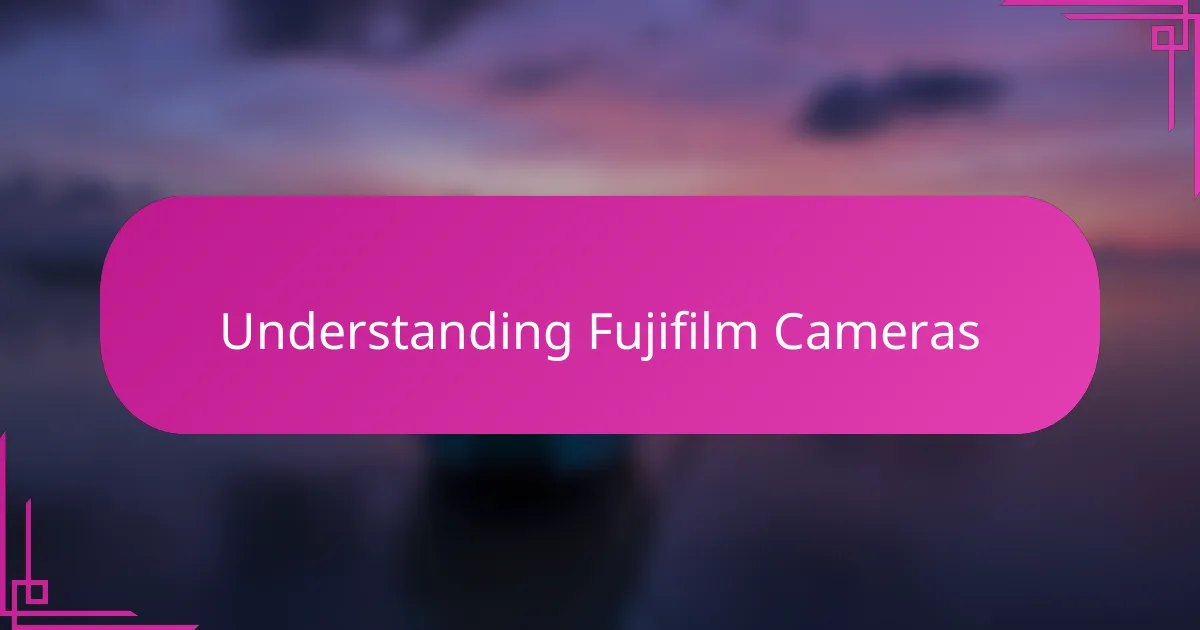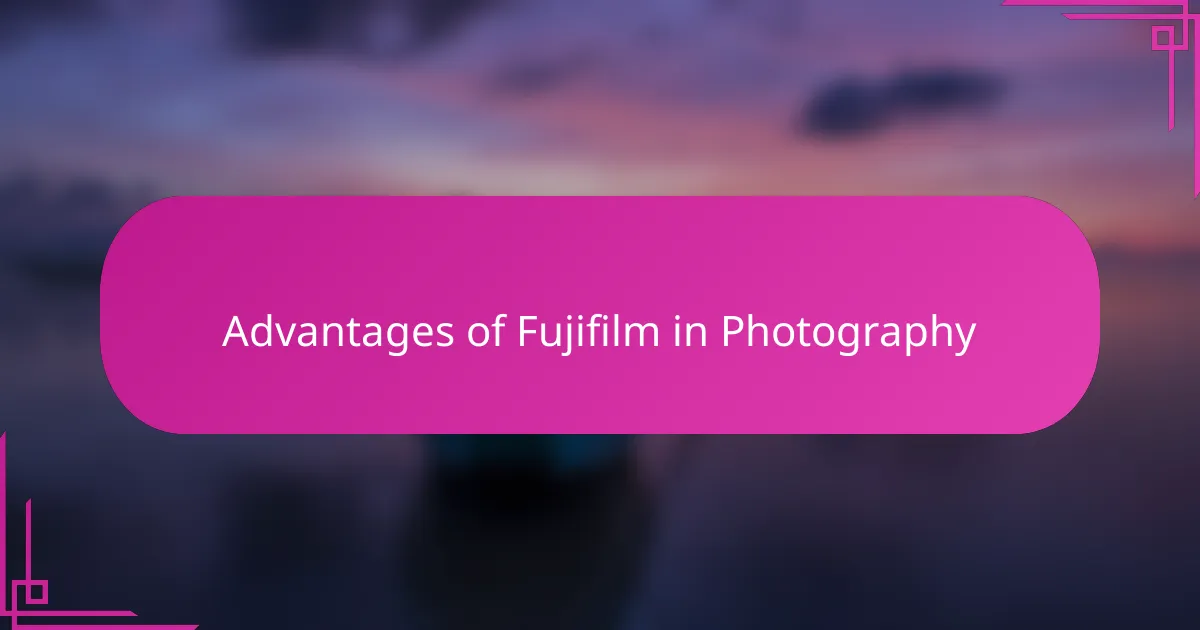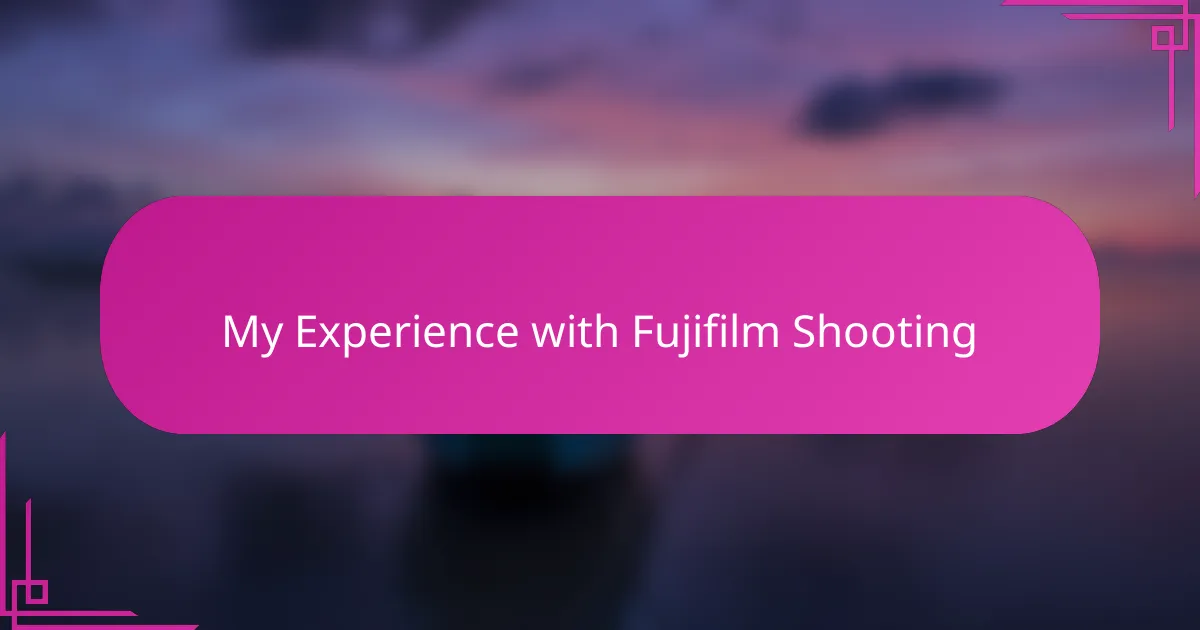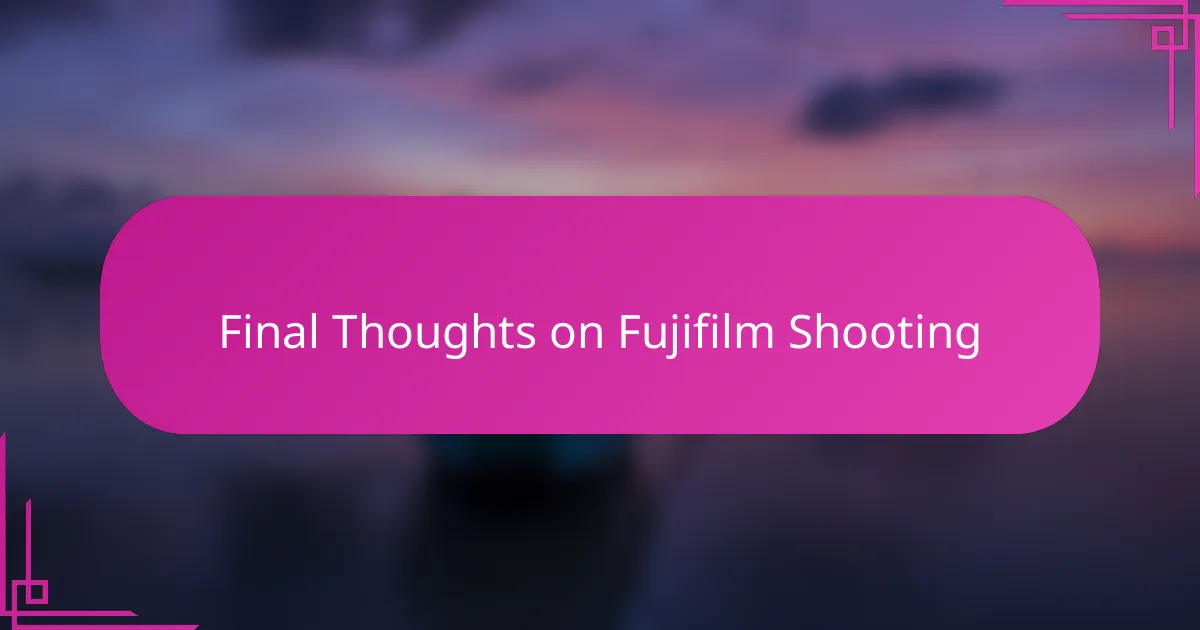Key takeaways
- Fujifilm cameras offer intuitive controls and tactile dials that enhance the shooting experience, allowing photographers to connect more deeply with their craft.
- The unique image quality and color science of Fujifilm replicate the warmth of classic film, making photos feel vibrant and alive.
- Features like film simulation modes and a robust build encourage creativity and provide reliability, especially in varying environmental conditions.
- Using Fujifilm fosters a sense of artistic collaboration, transforming photography into a thoughtful and immersive experience.

Understanding Fujifilm Cameras
When I first picked up a Fujifilm camera, I was struck by how intuitive the controls felt. The tactile dials for ISO, shutter speed, and exposure compensation instantly made me feel like I had complete command, unlike many digital cameras that bury these settings in menus. Have you ever handled a camera that just clicks with your instincts? That’s exactly the feeling Fujifilm cameras give me.
What really deepens my connection with these cameras, though, is the image quality and color science. Fujifilm’s commitment to replicating the look of classic film stocks always surprises me with its warmth and richness. It’s like holding a piece of photographic history in my hands, but with all the advantages of modern technology.
Another aspect I appreciate is how the design strikes a balance between nostalgia and innovation. The compact, often retro-inspired bodies invite creativity without overwhelming me with complexity. Isn’t it refreshing to use gear that feels as enjoyable as the results it produces? For me, Fujifilm cameras have become more than tools—they’re a part of the creative process itself.

Advantages of Fujifilm in Photography
What I find truly advantageous about Fujifilm is how its colors just pop with a natural vibrancy. When I review my shots, I often catch myself amazed at how true-to-life yet artistically enhanced the colors appear. Have you ever been surprised by how a color profile makes your image feel more alive? Fujifilm nails that balance every time.
Another thing that stands out is the seamless performance in low light. Using a Fujifilm camera on a gloomy evening, I noticed how the noise remained minimal and the details stayed crisp—a game changer when capturing moody scenes. This reliability really builds my confidence to shoot whenever inspiration strikes, regardless of lighting.
Plus, the lenses feel like an extension of my eye, offering sharpness and character that inspire me to craft each shot with intention. It’s not just technical excellence; it’s an emotional connection that makes me want to shoot more and experiment. Isn’t that connection what every photographer craves from their gear? With Fujifilm, I’ve found it.

Key Features of Fujifilm Cameras
One feature that instantly caught my attention with Fujifilm cameras is their APS-C sensor size. It strikes a perfect balance—not quite full-frame, but larger than many others—giving me sharp images with excellent detail, even when cropping. Have you ever felt restricted by your camera’s sensor? This one simply frees me up to explore composition without worrying about losing quality.
The film simulation modes are another game changer. I remember experimenting with Velvia and Classic Chrome for hours, amazed at how each preset transformed the mood of my photos without any post-processing. It feels like having a mini darkroom right inside the camera, which makes shooting more playful and creative. Isn’t it rare to find a camera that encourages you to shoot less like a machine and more like an artist?
Lastly, I can’t overlook the robust build and weather sealing on many Fujifilm models. Traveling in unpredictable weather used to stress me out, but these cameras handle rain and dust without flinching. Knowing my gear can keep up with my adventures adds a layer of confidence that helps me focus more on capturing moments and less on protecting my equipment. Doesn’t peace of mind make all the difference when you’re out shooting?

My Experience with Fujifilm Shooting
Shooting with Fujifilm quickly felt like more than just clicking a shutter—it became about embracing a rhythm I hadn’t found with other brands. I remember one afternoon, wandering through a vibrant market, and how effortlessly the camera captured the energy and colors around me. Have you ever experienced a moment where the camera just seems to anticipate your vision? That’s how it felt with Fujifilm.
What really struck me was how intuitive everything was during actual shooting. The tactile dials let me adjust settings on the fly, so I stayed immersed in the scene instead of fiddling with menus. It made me wonder, why settle for cameras that slow down the creative flow? For me, Fujifilm blurred the line between technology and feeling, making every shot feel intentional and alive.
Then, there’s the joy of reviewing images shortly after taking them. The film simulations often hit me with nostalgia and inspiration, reminding me why I love photography in the first place. Does it sound strange to say a camera can evoke emotion before you even upload your photos? With Fujifilm, I experienced moments like that, turning ordinary shoots into memorable creative adventures.

Practical Tips for Fujifilm Users
One practical tip I always share with fellow Fujifilm users is to get comfortable with those tactile dials early on. I used to ignore them, relying on menus, but once I embraced the physical controls, my shooting became fluid and instinctive. Have you tried dialing in your settings without looking? It’s liberating and keeps you connected to the moment.
Another useful habit I developed is customizing the function buttons to match my shooting style. Fujifilm cameras offer so much flexibility here, and tweaking these shortcuts saved me precious seconds during fast-paced shoots. I remember a street photography outing where accessing autofocus modes quickly made all the difference in capturing fleeting expressions.
Finally, don’t underestimate the power of the film simulation modes for on-the-spot creativity. Instead of waiting to edit later, I often experiment with profiles like Provia or Classic Chrome while shooting. It turns the experience into a playful exploration, and sometimes, the camera’s rendition surprises me in ways post-processing never could. Have you noticed how these modes can shift your photographic perspective?

Comparing Fujifilm to Other Brands
When I compare Fujifilm to brands like Canon or Nikon, what stands out immediately is Fujifilm’s insistence on tactile controls. While many cameras cram settings into menu systems, Fujifilm feels like it was built with photographers in mind—offering that satisfying click of dials that keep me connected to the shot. Doesn’t it make a difference when your camera feels more like a partner than a gadget?
From my experience, Fujifilm’s color science creates a signature look that’s hard to replicate elsewhere. Sure, Sony and Panasonic produce sharp, high-res images, but Fujifilm’s film simulations evoke a warmth and character that pull me in emotionally. Have you ever noticed how color can transform the mood of a photo? For me, that’s where Fujifilm shines beyond just technical specs.
On the flip side, I’ve found that Fujifilm’s APS-C sensor offers a sweet spot between size and image quality, but for those needing ultra-high resolution or full-frame reach, brands like Sony might lead the pack. Still, I appreciate how Fujifilm’s lens lineup is crafted with personality and sharpness that inspire creativity. Isn’t it refreshing when your gear encourages you to explore rather than just compete on numbers?

Final Thoughts on Fujifilm Shooting
Shooting with Fujifilm has left me with a sense of satisfaction that goes beyond just technical achievement. There’s this unique blend of control and creativity that keeps me coming back to the viewfinder, almost like the camera becomes an extension of my own vision. Have you ever used a camera that feels less like a tool and more like a collaborator? That’s exactly how Fujifilm resonates with me.
What truly sticks with me in my Fujifilm experience is how every shot seems deliberate yet effortless. The tactile dials and film simulations invite me to slow down and immerse myself in the moment, turning photography from a routine task into a thoughtful creative act. Isn’t it wonderful when your gear encourages you to be present rather than distracted?
Ultimately, shooting with Fujifilm feels like rediscovering why I fell in love with photography in the first place. There’s a warmth and character in each image that mirrors my own passion, making every frame feel like a small piece of art. If you haven’t tried Fujifilm yet, I wonder—what creative possibilities might you be missing out on?